Reprinted with permission from the West Side Rag.
Living down the block from the Dakota can be a trippy experience. That’s where John Lennon and Yoko Ono lived together from 1972 until December 8, 1980, when John was shot and killed in the building’s driveway as he and Ono came home that night. Today, seven days a week, giant buses disgorge throngs of tourists outside of the historic apartment building on West 72nd Street and Central Park West. The Tower of Babel can’t begin to compete with the number of languages spoken by these thousands of travelers.
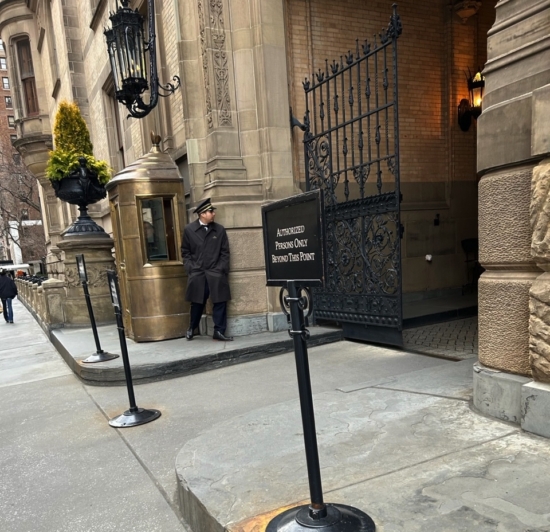
I am convinced that many of the pilgrims to the Dakota, too young or geographically distant to have experienced Beatlemania firsthand, have little or no idea why the building is even a stop on their itinerary. Time flies, fellow Boomers — the Beatles first appeared on The Ed Sullivan Show 60 years ago this month, in front of an audience of 73 million people.
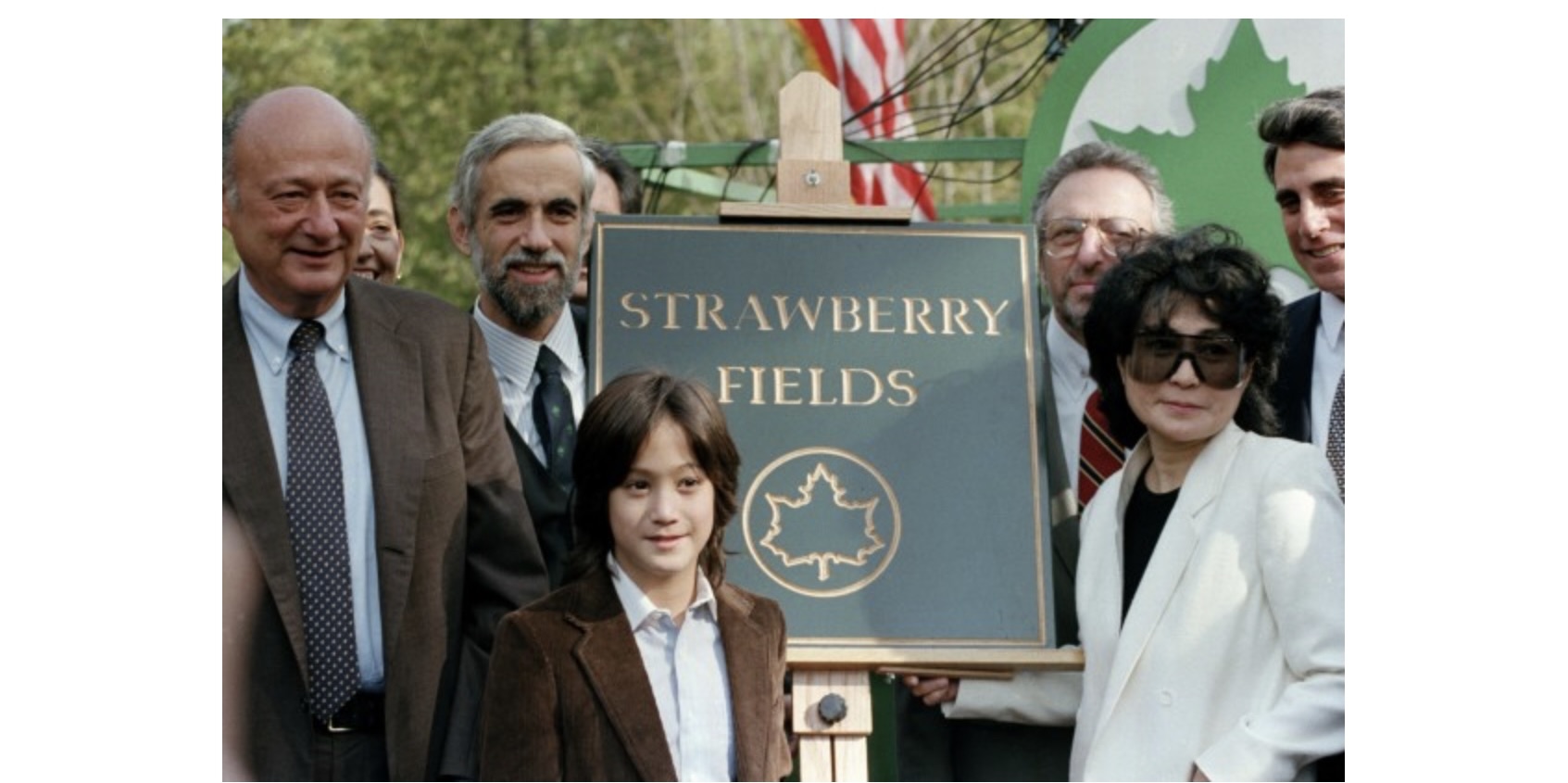
The groundbreaking ceremony for Strawberry Fields took place on March 21, 1984, with Yoko Ono’s and Lennon’s sons Julian and Sean in attendance. A bronze plaque lists 121 countries that endorsed this Garden of Peace.
Walking across the street to Strawberry Fields in Central Park afterwards is the best way for a visitor to appreciate the enormous loss the world suffered the day John died. A 2.5-acre section of Central Park, dedicated to John’s memory, is named after “Strawberry Fields Forever,” one of John’s greatest songs. The small stretch of land was renovated and landscaped after Ono donated $1 million for the project. Poignantly, the area was the site of John and Yoko’s last walk in Central Park.
Setting aside the emotional tug of the place, I have always suspected that Ono’s understandable ulterior motive for creating Strawberry Fields was to keep fanatical fans away from her front door (she continued to live in the Dakota until last year).
I’ll admit that I, like many other Beatles enthusiasts, was initially wary of Ono. She was widely blamed for having caused the breakup of the Beatles, and when I saw her perform with John in Ann Arbor in 1971, I thought her singing would more properly be described as shrieking.
But in the years since, I’ve become fond of Ono’s quirky art and grandiose pronouncements. It is impossible not to admire the magnitude of her lifelong love for John. I used to see her occasionally walking near the Dakota, understandably never alone. By any measure, Ono is the ultimate West Sider. Given what she suffered in this neighborhood, no one would have faulted her for moving to the other end of the world. Instead, she lived here for 50 years, only leaving in poor health last year at the age of 90 to live upstate.
In addition to being a sentimental journey — particularly for us Boomers who bought the “White Album” in vinyl — Strawberry Fields is a buzzing mini-hive of commerce. The popular tourist destination is ringed by pricey pedicab carriages that rent by the minute and hot dog vendors who charge $5 for a soda. Like so much of New York City, an important goal of the permanent industry at Strawberry Field is to fleece — er, entertain the tourists.
There should be a sign at the entrance of Strawberry Fields. “Abandon all hope of bargains, ye who enter here.” The hot dog stand at the gate helpfully takes all major credit cards. A hot-dog-and-soda snack for your family of four can run upwards of $50. Not highway robbery, but a plump price, nonetheless.
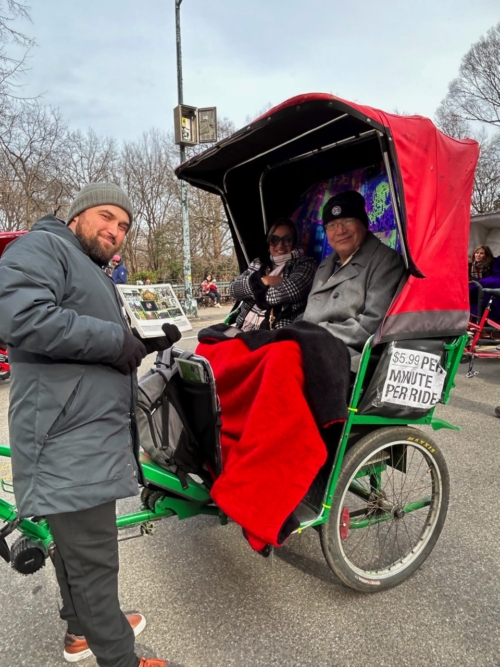
Pedicab drivers also take a handsome haul. Ali, originally from Tajikistan, told me he has been driving for 13 years. Riding in his carriage will set you back $5.99 a minute. Despite the price, Ali was dropping off a smiling couple from Phoenix when we spotted him on Super Bowl Sunday, and no one was complaining or counting pennies. A born showman, Ali was bursting with pride about his role in the tourist trade: “I love my job! I meet a lot of new people. And I own my own business, which is cool!”
Taking the winding path to the center of Strawberry Fields, tourists are further teased with various Lennon tchotchkes and memorabilia along the way. There are framed Lennon photos for sale, original paintings of John and Yoko, and of course Lennon pins by the dozens, at $4 a pop, 3 for $10.
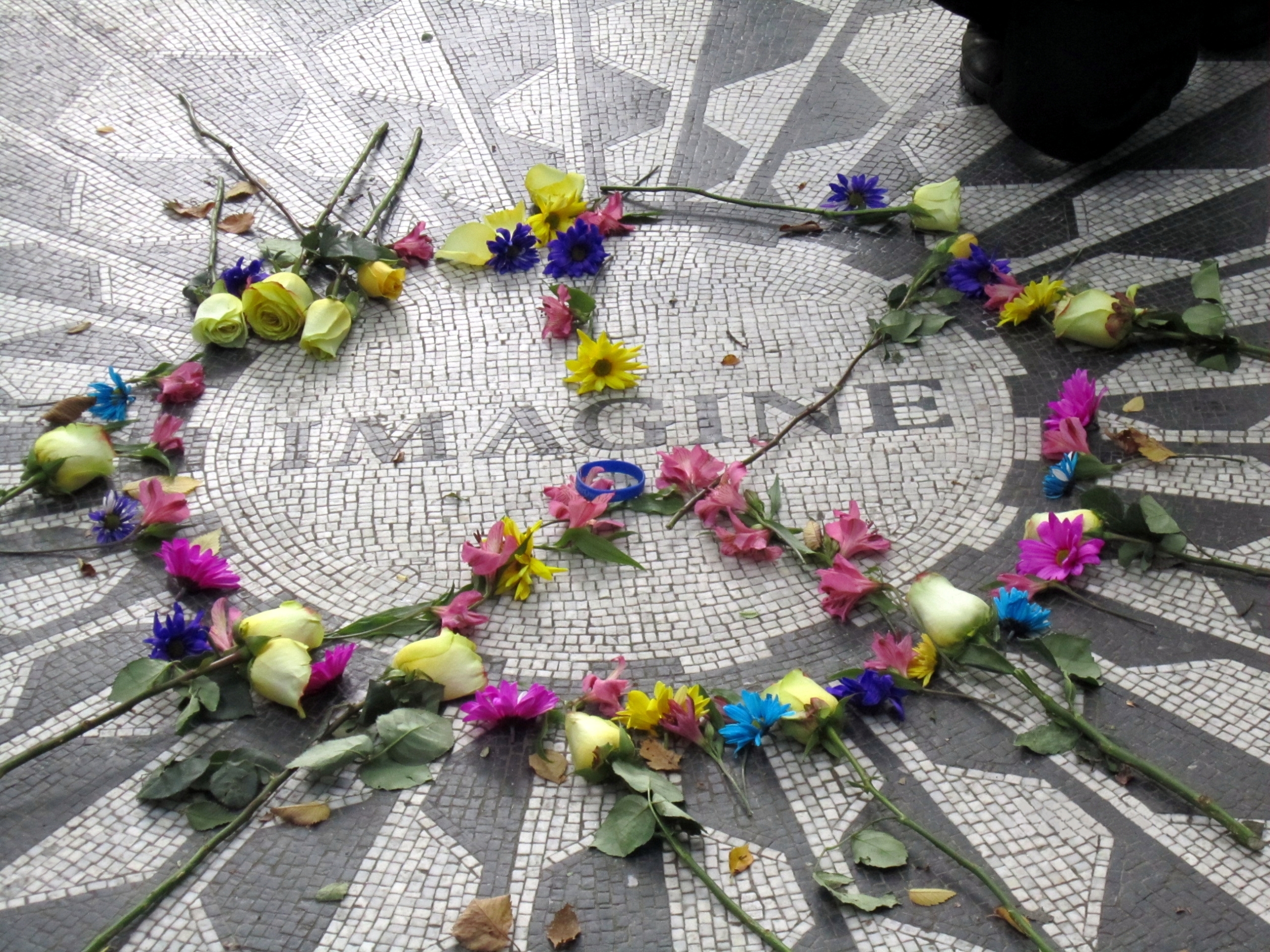
The beating heart of Strawberry Fields is the iconic circular IMAGINE mosaic at its center, which celebrates John’s most famous solo song. On busy days, visitors patiently queue up for a chance to pose for a photo there. The ever-present buskers at Strawberry Fields, who sing the best-loved tunes of both the Beatles and John Lennon, perform for cash from grateful crowds. Ranging from atonal to genuinely gifted, they evoke the youth and music that Lennon and the Beatles exemplified.
That’s where David Muniz comes in. Besides being a musician himself, he is the keeper of the invaluable schedule list for the buskers. This time of year, the busking day runs from 9 a.m. to sundown.
Rather than being an embodiment of John and Yoko’s pacifistic vision, though, Strawberry Fields has a dark past with a history of discord and fighting. When Muniz arrived to busk in 2013, he found a combative scene. “It was crazy,” he recalled in an interview with the Rag. “Bullies played all of the time. They didn’t let anyone else play.” Muniz said that when he complained, “they told me to screw myself.” Instead, he says with pride, “I kicked them out. I got rid of the bullies, and all the musicians came.”
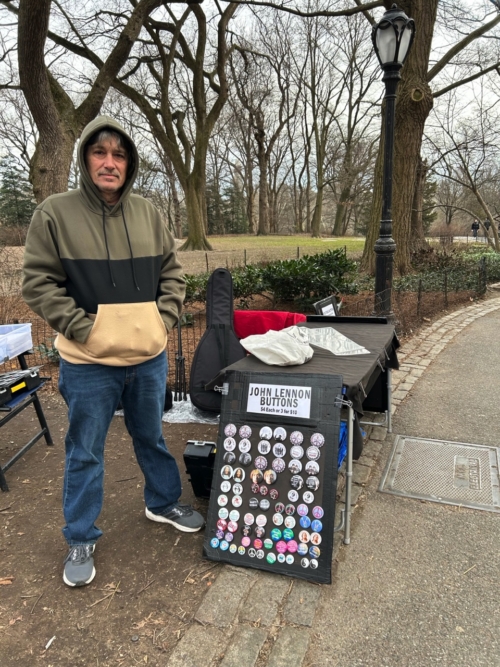
Although there are no auditions for buskers (“I’m not a judge,” said Muniz, though you have to go through him to get on the roster), the quality of the performances is usually impressive. How much money each of them makes from busking, though, is a closely held secret for competitive reasons. Muniz divulged, “Money is by the season. It’s cold now, so it’s the worst time of the year.” A busker might make $30 or $40 an hour in the cold weather. Summertime is the best, Muniz said. “I’ve gotten $100 bills.”
More important than a tip, though, is a word or a gesture from Ono, the governing spirit of Strawberry Fields. Each busker can remember the number of times they’ve been in her presence. In recent years, she has come, sometimes incognito, in her wheelchair to survey the site. To a person, the buskers, at times a tough crowd, describe these encounters in almost religious or mystical terms.
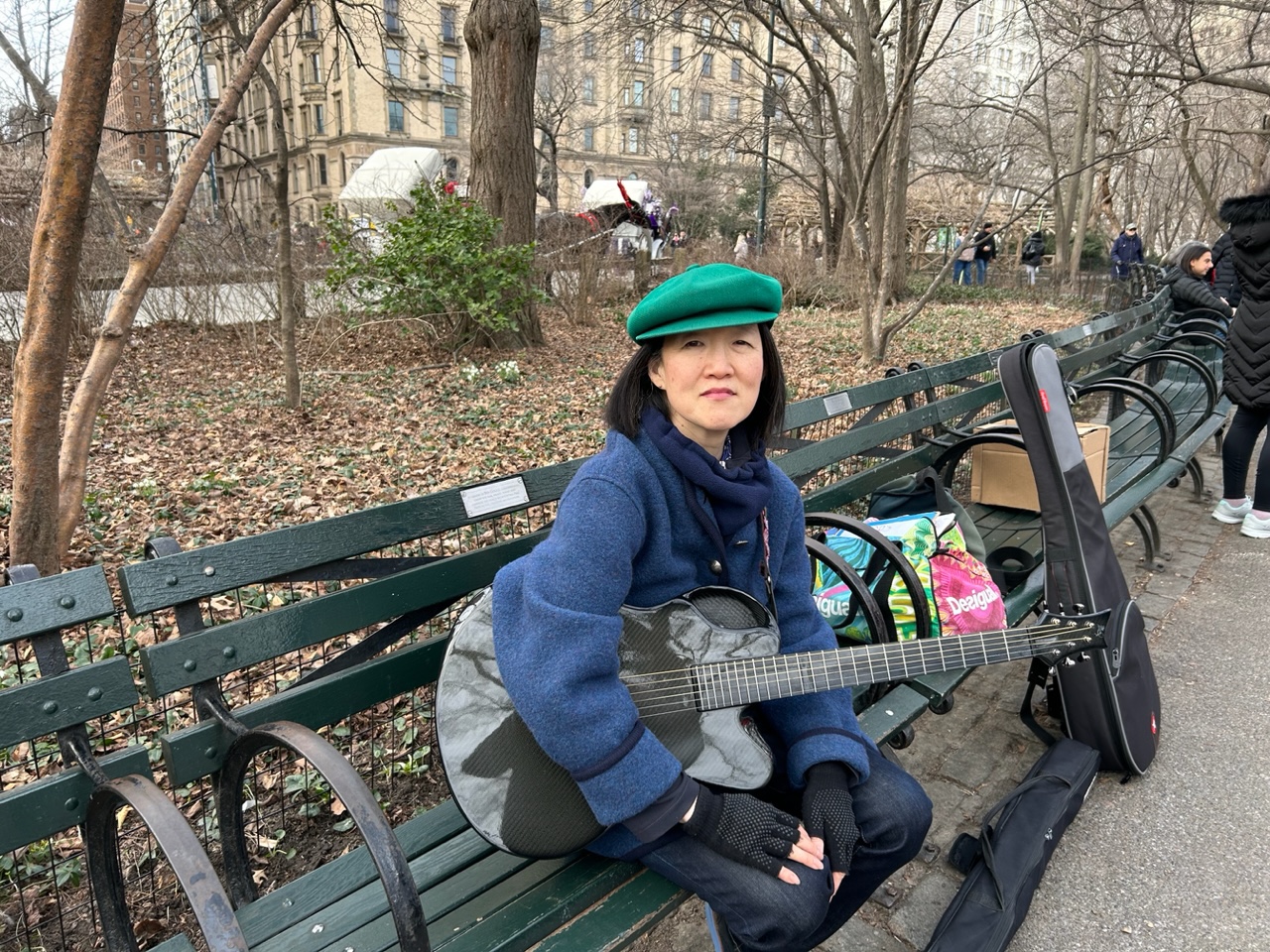
“One misty, rainy sort of day, I was setting up my artwork at Strawberry Fields,” recalls musician and artist Paulina Butterfly (her nom de busk). “There were very few people there. I turned around and I saw that Yoko was looking at my board of John Lennon pictures. I didn’t say anything because I was tongue-tied. Then she said that they were beautiful. That’s when I knew that I had her blessing.”
Paulina was the first female busking regular at Strawberry Fields. Born in San Francisco and educated at the University of California, Berkeley and New York’s Fashion Institute of Technology, Paulina honed her musical skills by performing karaoke. Nervous, she prepared for eight months before her debut performance at Strawberry Fields more than six years ago.
As a female busker there, it was tough sledding. She ran right into misogyny, she said: “Some other buskers used cavemen tactics. The boy’s club can be wary of women.”
Still, said Paulina, who is an administrative assistant during the day and busks with her guitar after work, “I never want to stop. There’s nothing better than this. I love the music and the immediate reaction.”
Not everyone at Strawberry Fields has journeyed a long way to get there. Dave, 73, a retired Upper West Sider who also lives six months a year in Madison, Wisconsin, walks daily in the park and often drops by there to enjoy the music and watch the excited tourists dance and sing. “It’s a joyous place,” said Dave, who shyly declined to give his last name. “The homeless people can be a little raucous, but they’re enjoying themselves too.” On Sunday, as the crowds thinned out to watch the Super Bowl, Dave was watching The Meetles, a four-person busking band that appears every Sunday.
I suspect that many people on the UWS avoid the area, thinking of it as a “tourists only” venue. But you don’t need to take a pedicab to get there. Like Dave, I plan to grab a few bucks for the buskers occasionally now and walk over. Imagine!
Comments
Sign in or become a Nu?Detroit member to join the conversation.
Just enter your email below to get a log in link.